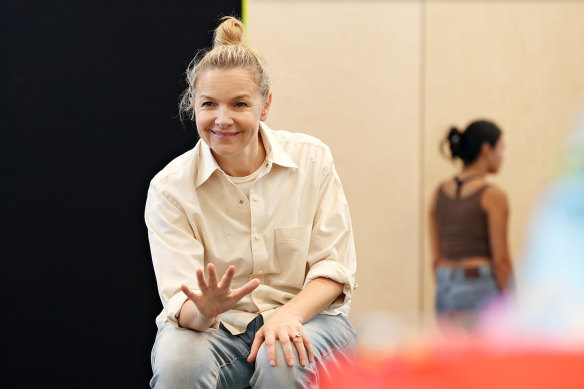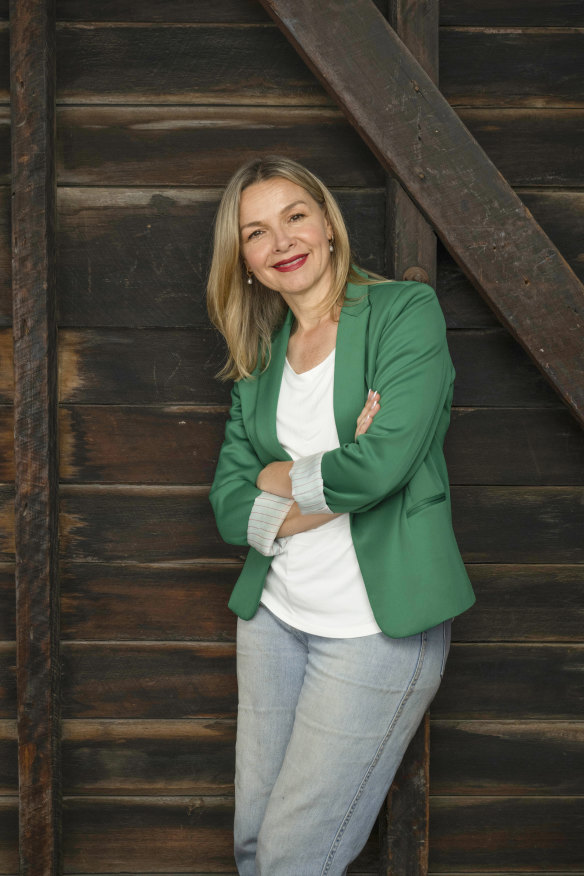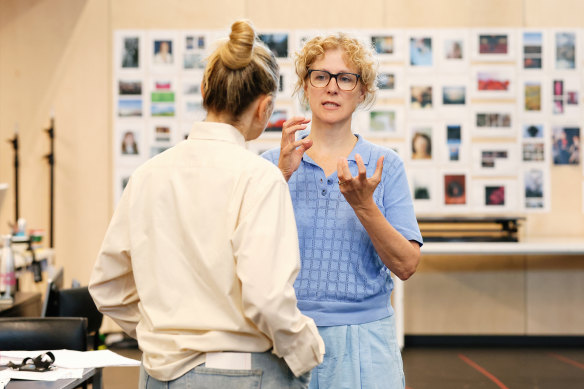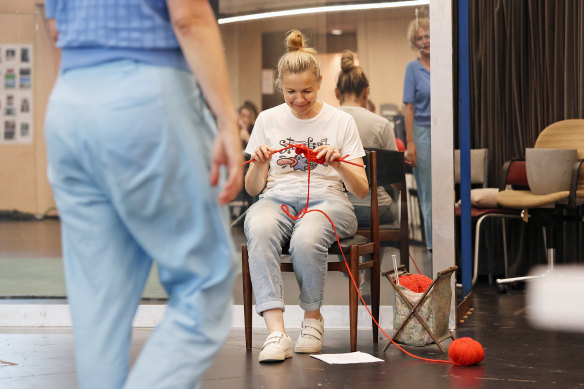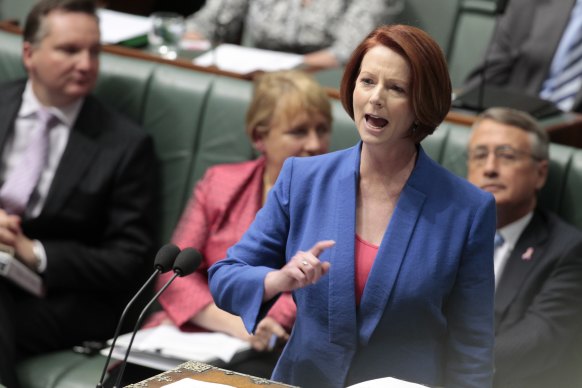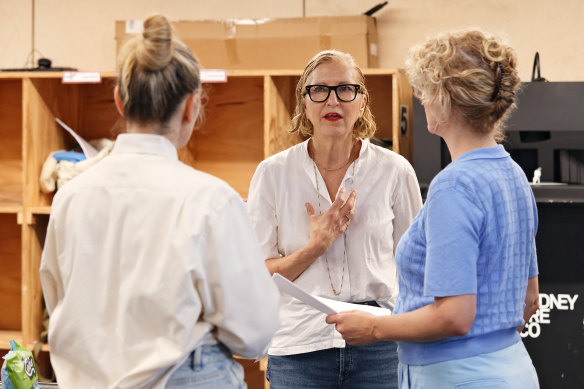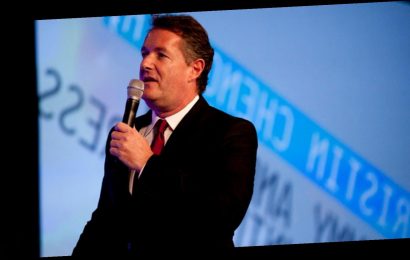By Louise Rugendyke
Justine Clarke in rehearsal for Julia at the Sydney Theatre Company.Credit:Prudence Upton
Justine Clarke has a neat party trick. She can recite Julia Gillard’s famous 2012 misogyny speech word for word.
From, “I will not be lectured about sexism and misogyny by this man”, to, “The leader of the opposition should think seriously about the role of women in public life and in Australian society because we are entitled to a better standard than this.” All 15 minutes of controlled fury, indignation and withering put downs.
“It’s an endurance test,” says Clarke. “Just being able to sort of sit inside an argument for that long. I don’t know where she had time to swallow.”
Clarke has been listening to the speech every day as she prepares to star in Julia for the Sydney Theatre Company. She even had to change the way she breathes to deliver it, mimicking the way politicians structure their sentences.
“To hear someone in flow mount such an extraordinary argument – and the poetry of it, the rhythm, the repetition – it was striking,” says Clarke of Gillard’s speech.Credit:Janie Barrett
“They breathe in the middle of a thought, so they can start the next thought without somebody interjecting,” she says. “So that’s been really interesting to see how [Gillard] pre-empts a response by breathing before, so she can push through to her next thought because she knows what’s going to come at her when she speaks.
“And just the stamina and the power of it. The dexterity and the fact it was off the cuff. I mean, she only did it once and I’m going to be doing it lots more. At the moment, I’ve just been doing it completely like a song, learning it like a song, which has been so fun and wonderful.”
Written by Joanna Murray-Smith and directed by Sarah Goodes, the play isn’t a straight biography of Gillard. Clarke is not wearing a red wig, but she does knit. It’s no Wharf Revue or At Home With Julia, but neither is it like STC’s recent one-woman show RBG: Of Many, One. It’s an imagining of the former prime minister’s life before that day on October 9, 2012.
‘I would probably shout and cry and storm out of the room. But it was 15 minutes of sustained argument – it’s virtuosic.’
“I start in the moments before the speech,” says Murray-Smith. “She’s about to start feeling that sense of absolute rage and righteousness. And she sort of goes back in time and tells us the story that leads her to this moment.
“So it’s not just a streamlined portrait of a politician, it’s really more about a woman who is coming to terms with what it means to be idealistic and ambitious. Because the idealism has to be compromised. That’s the way politics works. You want to stay in power, you’re making concessions to your own beliefs. And how do you manage that?”
For a quick refresher, Gillard delivered the speech after then-opposition leader Tony Abbott said her Labor government “should have already died of shame” after he challenged her to sack then-speaker Peter Slipper over sexist text messages. Only the year before, Abbott had stood in front of signs that read “Ditch the witch” and “Juliar Bob Browns [sic] bitch”.
Director Sarah Goodes talks to Justine Clarke in rehearsal for Julia. Credit:Prudence Upton
It was the latest in a stream of sexist abuse and double standards Gillard had endured – from fellow politicians, the media and the public. From the moment she became prime minister in 2010, her body and hair had been commented on. Her voice was mocked and one particular outfit was described as looking like “a cheap motel bedspread”.
So when Gillard sat through Abbott’s spiel in parliament that day, writing notes, she wasn’t just angry, she was ready to defend herself in a speech that has only grown in significance in the decade after it was delivered.
Initially dismissed by much of the media in Australia, the speech became a viral sensation.
The Macquarie Dictionary decided to broaden its definition of “misogyny” – from the old-fashioned “hatred of women” – to something closer to sexism “with a stronger edge to it”. While Guardian Australia readers voted it the “most unforgettable moment” in Australian TV history. Even then-US president Barack Obama’s staff have admitted to watching it whenever they were “really annoyed at Abbott”. You can even buy it printed on a tea towel.
Clarke on the tools in Julia. Credit:Prudence Upton
Clarke is sitting with Goodes during a break in rehearsal at Walsh Bay. Clarke carries the burden of the show – although she will be joined on stage by a silent witness, played by Jessica Bentley, who represents the younger generation. It’s a lot, especially when you consider this is Clarke’s second one-woman show in a row, following Girls & Boys at the Sydney Festival, for which she received rave reviews.
Goodes jokes that Clarke is an athlete, and she is her coach, running alongside her, spraying her with a water bottle and shouting, “C’mon Juzzy, you can do it! Just get out there, it’s not hard.”
Both women remain in awe at the power of Gillard’s speech, not just for its content but for the theatrical way it was delivered. It’s a one-woman show in itself, as it veers between rage, high drama and, yes, comedy.
“She was at the height of her parliamentary powers and her oratory powers had been worked like such a muscle all her life,” says Clarke. “To hear someone in flow mount such an extraordinary argument – and the poetry of it, the rhythm, the repetition – it was striking.
“If it was me [delivering the speech], I would probably shout and cry and storm out of the room. But it was 15 minutes of sustained argument – it’s virtuosic.”
Would Goodes have any directing notes for Gillard?
Then-prime minister Julia Gillard replies to a motion by then-opposition leader Tony Abbott on the day of her famous misogyny speech in 2012.Credit:Andrew Meares
“You wouldn’t want to touch it,” she says. “It’s so alive. Because, ultimately, directing is about working with the actor and the writer to make sure the performer has it in their atoms. So that when they’re stepping into it, they’re not thinking, ‘Am I going to put that there?’ You want them to be just channelling that emotional drive or the argument, and that’s where the magic is.
“And once you really understand it and get it, then you’re free as a bird to do it. Which she was. It was such control, but she was free.”
Murray-Smith, who I had talked to earlier on Zoom (in a very Gillard way, she was sitting in front of a bright red wall), had a similar reaction. “As a playwright. I was just thinking, the drama and the power of this piece of oratory was so extraordinary.
“We hadn’t really glimpsed much of the spontaneous Gillard. Everything had always been so measured and controlled. It was stunning.”
Murray-Smith was commissioned by STC to write the show, a co-production with the Canberra Theatre Centre, and before she started writing, she contacted Gillard’s office to let them know what she was doing. Murray-Smith had decided if Gillard said no, she wouldn’t continue because, “I felt, just on a woman-to-woman level, she’d been through enough without having any more anxiety”.
Playwright Joanna Murray-Smith with Clarke and Goodes during rehearsal for Julia. Credit:Prudence Upton
Gillard, however, agreed. “She said, ‘I won’t endorse it. But I’m fine with you writing it’,” recalls Murray-Smith. “Well, I didn’t want her to endorse it. Because I didn’t want to feel beholden to her. I wasn’t sure how I was going to feel about her entirely. Because there were certainly areas that I was disappointed in, in her leadership. So, I was not at all uncritical.
“But once she said she didn’t mind, I thought, ‘OK, let’s run with this.’ It’s an incredibly audacious idea to imagine your way into the head of someone who is still alive and somewhat well known. But I couldn’t resist it.”
Murray-Smith then interviewed Gillard for the play and they clicked. “I assumed that someone who had been so badly treated would be, quite rightly, defensive and wary. I couldn’t find her remotely defensive or wary. She was open, generous, helpful, and really delightful person to talk to. I wanted to just have a coffee with her and talk about shoes.”
The resulting play, says Murray-Smith, is “absolutely my version. There are a few quotes that are directly from her, but not very many. And there are some quotes that were lobbed at her. And the chronology is correct and a lot of the detailed factual detail is correct, but all her ruminating in the play is completely hypothetical.
“But I’m hoping that it’s persuasive. Because the thing is, she’s never going to let us in. That’s just not who she is.”
For Clarke, the toughest thing has been the rehearsal room. For what’s essentially a one-woman show, she is missing the critical piece of the puzzle: the audience.
“They are part of the show,” says Clarke. “So what is strange is being in this rehearsal room without them. It’s quite lonely and scary.”
Is she worried about Gillard possibly coming to see it (for the record, Gillard has not said if she is coming)?
“Once you’re in there, everyone’s decided to come,” she says. “So I don’t really mind who I see. It’s actually worse when you’re not directly addressing the audience because you catch people’s eye and you’re not supposed to. You look over and there’s George Miller or something. But when you’re just boldly addressing the audience, it’s really quite freeing.”
The last word though, belongs to Gillard.
“Her last incredible statement [in the speech], is the thing that stayed with me,” says Clarke. “She just comes back to women – ‘You should think seriously about the role of women in public life and in Australian society.’
“She says we, she makes it about women. That last moment is just the clincher. And it was the clincher, in terms of when you listen to it, you just go ‘Oh, wow. Yeah, we did that, actually. We did think seriously about that.’”
Julia is at the Drama Theatre, Sydney Opera House, from March 31 to May 13.
A cultural guide to going out and loving your city. Sign up to our Culture Fix newsletter here.
Most Viewed in Culture
Source: Read Full Article
